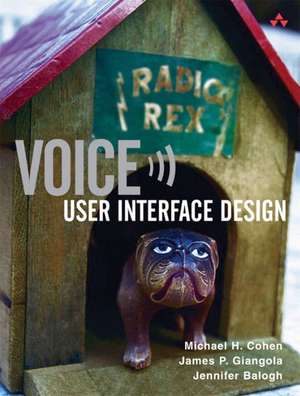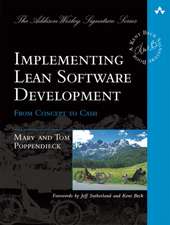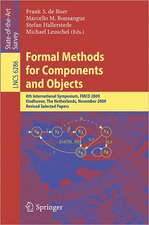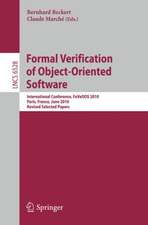Voice User Interface Design: Rhet Brf W/MLA& LM Writrs Jrnl
Autor Cohen Michaelen Limba Engleză Paperback – 31 ian 2004
- Automated speech recognition applications are poised for phenomenal growth, because they provide companies with a distinct competitive advantage
- Important design principles and guidelines are illustrated using a running sample application
- The companion website will have audio clips for all the examples in the book, which will bring the examples to life for the reader
Preț: 358.92 lei
Preț vechi: 448.65 lei
-20% Nou
68.70€ • 74.15$ • 57.60£
Carte tipărită la comandă
Livrare economică 19 aprilie-03 mai
Specificații
ISBN-10: 0321185765
Pagini: 336
Ilustrații: illustrations
Dimensiuni: 181 x 233 x 23 mm
Greutate: 0.71 kg
Ediția:1
Editura: Addison-Wesley Professional
Locul publicării:Boston, United States
Descriere
The book begins with an overview of VUI design issues and a description of the technology. The authors then introduce the major phases of their methodology. They first show how to specify requirements and make high-level design decisions during the definition phase. They next cover, in great detail, the design phase, with clear explanations and demonstrations of each design principle and its real-world applications. Finally, they examine problems unique to VUI design in system development, testing, and tuning. Key principles are illustrated with a running sample application.
A companion Web site provides audio clips for each example: www.VUIDesign.org
The cover photograph depicts the first ASR system, Radio Rex: a toy dog who sits in his house until the sound of his name calls him out. Produced in 1911, Rex was among the few commercial successes in earlier days of speech recognition. Voice User Interface Design reveals the design principles and practices that produce commercial success in an era when effective ASRs are not toys but competitive necessities.
Cuprins
About the Authors and Radio Rex.
Preface.
I. INTRODUCTION.
1. Introduction to Voice User Interfaces.
What Is a Voice User Interface?Why Speech?Where Do We Go from Here?2. Overview of Spoken Language Technology.
Architecture of a Spoken Language System.The Impact of Speech Technology on Design Decisions.Conclusion.3. Overview of the Methodology.
Methodological Principles.Steps of the Methodology.Applying the Methodology to Real-World Applications.Conclusion.II. DEFINITION PHASE: REQUIREMENTS GATHERING AND HIGH-LEVEL DESIGN.
4. Requirements and High-Level Design Methodology.
Requirements Definition.High-Level Design.Conclusion.5. High-Level Design Elements.
Dialog Strategy and Grammar Type.Pervasive Dialog Elements.Conclusion.6. Creating Persona, by Design.
What Is Persona?Where Does Persona Come From?A Checklist for Persona Design.Persona Definition.Conclusion.7. Sample Application: Requirements and High-Level Design.
Lexington Brokerage.Requirements Definition.High-Level Design.Conclusion.III. DESIGN PHASE: DETAILED DESIGN.
8. Detailed Design Methodology.
Anatomy of a Dialog State.Call Flow Design.Prompt Design.User Testing.Design Principles.Conclusion.9. Minimizing Cognitive Load.
Conceptual Complexity.Memory Load.Attention.Conclusion.10. Designing Prompts.
Conversation as Discourse.Cohesion.Information Structure.Spoken Versus Written English.Register and Consistency.Jargon.The Cooperative Principle.Conclusion.11. Planning Prosody.
What Is Prosody?Functions of Prosody.Stress.Intonation.Concatenating Phone Numbers.Minimizing Concatenation Splices.Pauses.TTS Guidelines.Conclusion.12. Maximizing Efficiency and Clarity.
Efficiency.Clarity.Balancing Efficiency and Clarity.Conclusion.13. Optimizing Accuracy and Recovering from Errors.
Measuring Accuracy.Dialog Design Guidelines for Maximizing Accuracy.Recovering from Errors.Conclusion.14. Sample Application: Detailed Design.
Call Flow Design.Prompt Design.User Testing.Conclusion.IV. REALIZATION PHASE: DEVELOPMENT, TESTING, AND TUNING.
15. Development, Testing, and Tuning Methodology.
Development.Testing.Tuning.Conclusion.16. Creating Grammars.
Grammar Development.Grammar Testing.Grammar Tuning.Conclusion.17. Working with Voice Actors.
Scripting for Success.Choosing Your Voice Actor.Running a Recording Session.Conclusion.18. Sample Application: Development, Testing, and Tuning.
Development.Testing.Tuning.19. Conclusion.
Appendix.
Bibliography.
Index.
Notă biografică
James Giangola is an industrial linguist, who designs, researches, and mentors others in creating VUIs that reflect the linguistic features and principles that shape everyday, human-to-human conversations. An innovator in prompt-writing and dialog design, James has ten years of experience teaching languages and linguistics, and maintains a consulting practice.
Jennifer Balogh is a speech consultant at Nuance Communications, where she designs and evaluates interfaces for spoken language systems. She also conducts research on dialog design techniques and holds several patents. Jennifer is a university lecturer and frequent contributor to conferences and journals.
0321185765AB11172003
Caracteristici
° Automated speech recognition applications are poised for phenomenal growth, because they provide companies with a distinct competitive advantage
° Important design principles and guidelines are illustrated using a running sample application
° The companion website will have audio clips for all the examples in the book, which will bring the examples to life for the reader
Textul de pe ultima copertă
This book is a comprehensive and authoritative guide to voice user interface (VUI) design. The VUI is perhaps the most critical factor in the success of any automated speech recognition (ASR) system, determining whether the user experience will be satisfying or frustrating, or even whether the customer will remain one. This book describes a practical methodology for creating an effective VUI design. The methodology is scientifically based on principles in linguistics, psychology, and language technology, and is illustrated here by examples drawn from the authors' work at Nuance Communications, the market leader in ASR development and deployment.
The book begins with an overview of VUI design issues and a description of the technology. The authors then introduce the major phases of their methodology. They first show how to specify requirements and make high-level design decisions during the definition phase. They next cover, in great detail, the design phase, with clear explanations and demonstrations of each design principle and its real-world applications. Finally, they examine problems unique to VUI design in system development, testing, and tuning. Key principles are illustrated with a running sample application.
A companion Web site provides audio clips for each example: www.VUIDesign.org
The cover photograph depicts the first ASR system, Radio Rex: a toy dog who sits in his house until the sound of his name calls him out. Produced in 1911, Rex was among the few commercial successes in earlier days of speech recognition. Voice User Interface Design reveals the design principles and practices that produce commercial success in an era when effective ASRs are not toys but competitive necessities.























